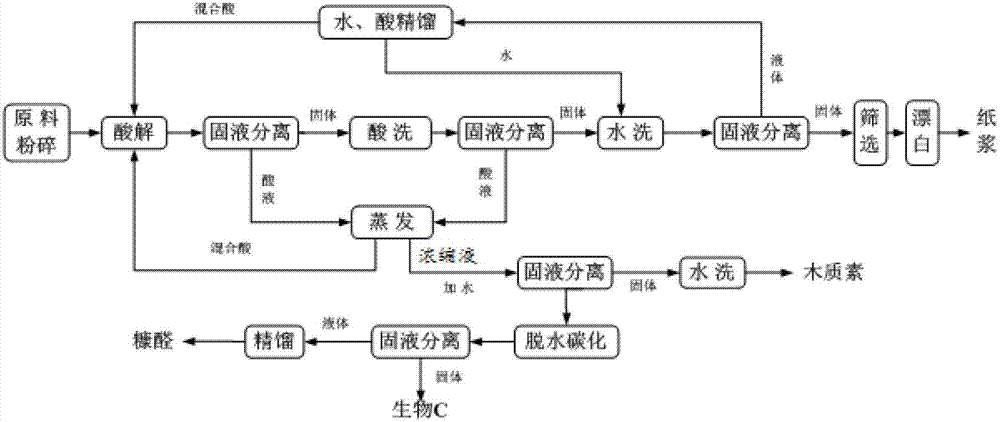Comprehensive utilization technology of biomass raw materials
A technology for biomass raw materials and processes, applied in the field of comprehensive utilization of biomass raw materials, can solve the problems of lignin loss, difficult lignin extraction, carbonization, etc., and achieve the effects of aggravating degradation and dissolution, shortening cooking time, and simple process route.
- Summary
- Abstract
- Description
- Claims
- Application Information
AI Technical Summary
Problems solved by technology
Method used
Image
Examples
Embodiment 1
[0055] In this example, the biomass raw material is reed (mass component composition: 49.5% cellulose, 22.7% hemicellulose content, 18.9% lignin), first crushed, washed with water to remove dust and crushed to a particle size of 0.5-20cm.
[0056] The present embodiment comprises the following steps from the comprehensive utilization process of the biomass raw material:
[0057] (1) After the reeds are crushed and pretreated, the treated reeds are cooked with an organic acid solution with a total acid concentration of 60% formic acid and acetic acid. The mass ratio of acetic acid to formic acid in the organic acid solution in this embodiment is 6: 1, and before adding the reed raw material, add 1% hydrogen peroxide (H 2 o 2 ) as a catalyst, control the reaction temperature at 80°C, react for 10 minutes, the solid-liquid mass ratio is 1:8, and conduct the first solid-liquid separation of the obtained reaction liquid;
[0058] (2) The above-mentioned separated solid is added ...
Embodiment 2
[0071] In this embodiment, the rice straw (ingredient composition: 35.8% cellulose, 28.6% hemicellulose, 14.3% lignin) was first crushed to a particle size of 0.5-20 cm.
[0072] The present embodiment comprises the following steps from the comprehensive utilization technique of described rice straw:
[0073] (1) After the rice straw is pulverized and pretreated, use an organic acid solution with a total acid concentration of 65% formic acid and acetic acid to cook the treated rice straw. The mass ratio of acetic acid to formic acid in the organic acid solution of this embodiment is 25: 1, and before adding the straw raw material, add hydrogen peroxide (H 2 o 2 ) as a catalyst, control the reaction temperature at 90°C, react for 20 minutes, the solid-liquid mass ratio is 1:5, and conduct the first solid-liquid separation of the obtained reaction liquid;
[0074](2) adding the solid obtained by the above separation into an organic acid solution of formic acid and acetic acid ...
Embodiment 3
[0087] In this example, the biomass raw material is bamboo chips (ingredient composition: 47.3% cellulose, 24.6% hemicellulose, 25.8% lignin), first crushed, washed with water to remove dust and crushed to a particle size of 0.5 -20cm.
[0088] The comprehensive utilization technology of bamboo chip described in the present embodiment, comprises the steps:
[0089] (1) After the pretreatment of the bamboo chips, use an organic acid solution with a total acid concentration of 70% formic acid and acetic acid to cook the treated rice straw. The mass ratio of acetic acid to formic acid in the organic acid solution of this embodiment is 19 : 1, and before adding the bamboo chip raw material, add hydrogen peroxide (H 2 o 2 ) as a catalyst, control the reaction temperature at 100°C, react for 30 minutes, the solid-liquid mass ratio is 1:6, and conduct the first solid-liquid separation of the obtained reaction liquid;
[0090] (2) adding the solid obtained from the above separation...
PUM
| Property | Measurement | Unit |
|---|---|---|
| heating value | aaaaa | aaaaa |
| heating value | aaaaa | aaaaa |
| heating value | aaaaa | aaaaa |
Abstract
Description
Claims
Application Information
 Login to View More
Login to View More - R&D
- Intellectual Property
- Life Sciences
- Materials
- Tech Scout
- Unparalleled Data Quality
- Higher Quality Content
- 60% Fewer Hallucinations
Browse by: Latest US Patents, China's latest patents, Technical Efficacy Thesaurus, Application Domain, Technology Topic, Popular Technical Reports.
© 2025 PatSnap. All rights reserved.Legal|Privacy policy|Modern Slavery Act Transparency Statement|Sitemap|About US| Contact US: help@patsnap.com

